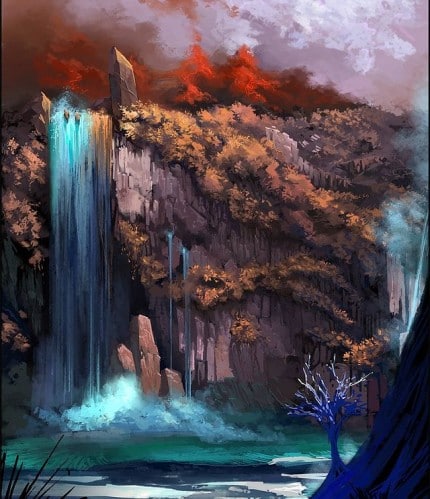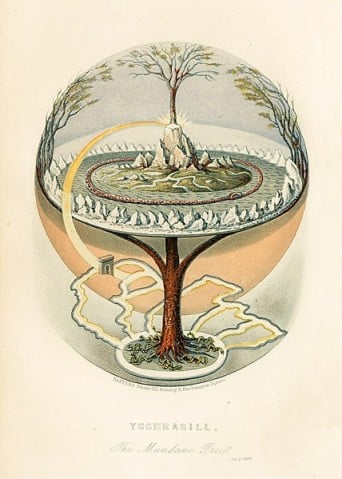Nestled in the primordial embrace of Norse cosmology, Hvergelmir stands as a well of profound significance, its waters as ancient as the world itself. This isn’t just any old spring; it’s the very source from which the rivers of mythology flow, a place shrouded in the mists of the Norse creation tales. As we delve into the depths of this mythical well, we uncover a narrative steeped in the arcane mysteries of the Norse universe, a fundamental element in the grand tapestry of Yggdrasil, the World Tree.
Hvergelmir Key Facts
| Location | Niflheim, beneath root of Yggdrasil |
| Origins | Part of the primordial realm Niflheim |
| Old Norse | Hvergelmi |
| Known for | Source of the Élivágar rivers |
| Inhabitants | Níðhöggr and other serpents |
| Associated myths | Creation of the cosmos, Sustaining Yggdrasil |
Name and Etymology

The name ‘Hvergelmir’ is a compound of Old Norse words where the meaning isn’t crystal clear (often the case). “Hver” (from hverr) can have a few meanings, but the most logical here is either “cauldron” or “boiling”. The same Old Norse word is used when Tyr and Thor go to fetch a cauldron from Tyr’s father Hymir.
The second part, “-gelmir” is not uncommon, also as parts of jötun names. In Vafthrudnirsmál, stanza 29 we find three such names.
A great many years before the earth was formed,
Bergelmir was born;
Thrúdgelmir was the father of this one,
And Aurgelmir the grandfather.
Aurgelmir is another name for Ymir, the first of the jotnar. In all these instances, “-gelmir” is understood as “yeller” or “roaring”. I have seen -yeller being used here and there, but to me, that makes less sense than “roaring”. So, Bergelmir is Bear Yeller, Thrudgelmir is Strength Yeller and Aurgelmir is Gravel/Sand Yeller. When translating -’gelmir’ as “roaring” instead, you get for example “Bear Roarer”, or “Roaring Bear” which to me seems more plausible as a name.
Putting them together, and translating them directly we get Cauldron/Boiling-Yeller/Roaring. Using “boiling” doesn’t quite capture the meaning I think, and when translating it, Yelling/Roaring Cauldron is more correct. I believe the most accurate meaning of Hvergelmir is Roaring Cauldron. Like the roar of a waterfall, or a lion, the name captures the roar of this primordial well, bubbling and overflowing with its poisonous waters.
Other translations of the name
Having searched a bit for other peoples takes on this I saw this at Wikipedia; “bubbling boiling spring”. This name makes no sense to me. Neither –hverr or –gelmir lends itself to “spring”. With some imagination, both bubbling and boiling could be derived from -hverr, but then the name would be Hverhver, which it certainly isn’t.
Seen from an Icelandic Perspective
While a “Roaring Cauldron” might seem like a strange name for a well, I think the right perspective helps. The first Viking discovered Iceland around 830 CE by someone who had been blown far off course by a storm. Iceland is an island of boiling hot springs, volcanoes and geysers. In that kind of environment, far out on the edge of their known world, a Roaring Cauldron makes sense.
Origins of the well Hvergelmir
Hvergelmir’s story begins before even the dawn of the Norse cosmos. It goes back to the time before creation. There were two great primordial realms, Niflheim of mist and ice, and the fiery Muspelheim, floating in infinite space. Deep in Niflheim, Hvergelmir bubbling with poisonous waters, was the spring which fed the great rivers known as the Élivágar. These poisonous rivers flowed out from Niflheim, freezing over, reaching ever longer into the Ginnungagap.

It was out there, in the frozen void between Niflheim and Muspelheim that life would emerge. Coming out of the primordial pool of poisonous water, Ymir (Old Norse name Aurgelmir) the first jötun would emerge. He would later be joined by Buri, first of the Aesir, emerging from the ice itself.
Even though it is described as poisonous and inhabited by monstrous snakes, Hvergelmir is the source of all life. Compared to other stories about mythical springs or wells of life, the Norse version is pretty bleak.
Yggdrasil draws water from Hvergelmir
Maybe as important as creating the pools which gave rise to the first life, Hvergelmir also sustains Yggdrasil. It is one of the three wells, alongside Urðarbrunnr and Mímisbrunnr, which each feeds one of Yggdrasil’s three roots.

However, living in the bubbling, poisonous waters of Hvergelmir is the dragon Nidhogg and countless other serpents. They are gnawing at the roots of Yggdrasil, causing hurt and decay.
This is a great example of the duality you often find in Norse mythology. In the same way many of the gods are torn between opposing forces, good and evil, benevolent or cruel.
The well of Hvergelmir is one of the wells Yggdrasil draws water from, but it is also causing its decay. The decay of the roots might be part of the reason why Hel and the dead escape Helheim to launch their attack on the gods during Ragnarök.
To say that the relationship between Hvergelmir and Yggdrasil is complicated is an understatement.
Mentions of Hvergelmir in Ancient Texts
Poetic Edda
Grímnismál
The Poetic Edda, a collection of Old Norse poems from the 13th century, provides a rare but significant mention of Hvergelmir in the poem “Grímnismál.” This poem is a treasure trove of mythological knowledge, conveyed through the voice of the god Odin, disguised as Grímnir. It describes the cosmic hart Eikthyrnir, whose antlers drip with moisture that falls into Hvergelmir, the source from which all waters rise:
“Eikthyrnir the hart is called, that stands o’er Odin’s hall, and bites from Lærad’s branches; from his horns fall drops into Hvergelmir, whence all waters rise.”
Note that Lærad, is another name for Yggdrasil, and “Odin’s hall” here refers to Valhalla. Following this stanza, a litany of river names is presented, some flowing to the abode of the gods and others to the realms of the dead, illustrating the well’s vast influence.
Prose Edda
Gylfaginning
In the Prose Edda, written by Snorri Sturluson, Hvergelmir is mentioned several times, but only in the section known as “Gylfaginning.” Here, the well is depicted as a central feature of Niflheim, the misty realm of the dead:
“It was many ages before the earth was created that Niflheim was made, and in its midst lies a spring called Hvergelmir, and from it flows the rivers called Svol, Gunnthra, Fiorm, Fimbulthul, Slidr and Hrid, Sylg and Ylg, Vid, Leiptr; Gioll is next to Hell-gates.”
This description not only places Hvergelmir in Niflheim, but also names the rivers that emerge from it, underscoring its foundational role in the Norse cosmological structure. However, the Élivágar rivers do vary a bit in name and number, depending on the source.
Yggdrasil’s Roots
Another mention within “Gylfaginning” highlights the relationship between Hvergelmir and Yggdrasil. The text describes the three great roots of the World Tree, one of which stretches over Niflheim where Hvergelmir lies beneath:
“Beneath this root is the spring Hvergelmir, and the base of the root is gnawed on by the dragon Níðhöggr.”
This passage details how the well is sustaining Yggdrasil, but also describes the menacing presence of Níðhöggr, adding a layer of drama to the well’s narrative.
The Stag Eikþyrnir
The Prose Edda also recounts the origin of the waters of Hvergelmir through the stag Eikþyrnir:
“The stag Eikþyrnir stands on top of the afterlife hall Valhalla feeding branches of Yggdrasil, and from the stag’s antlers drips great amounts of liquid down into Hvergelmir.”
This vivid imagery serves to reinforce the interconnectedness of life, death, and the sustaining forces of the cosmos. Personally, I am struck a bit about how both the cycle of water, or life inherent in this process. Eikthyrnir eats from the leaves, water drips from his antlers into Hvergelmir, which nourished the tree from which the great stag eats.
Náströnd’s Unpleasantries
Lastly, Hvergelmir is mentioned in relation to the dreaded Náströnd, a shore laden with the corpses of the dishonorable dead:
“There Nidhogg torments the bodies of the dead.”
This quote from “Völuspá” within the Prose Edda frames Hvergelmir not just as a source of life-giving waters but also as a realm of torment, further enriching the complex tapestry of Norse eschatology.
Frequently Asked Questions
In Norse cosmology, the well is the source of many rivers and is vital for the sustenance of Yggdrasil, the World Tree, making it a cornerstone of life for the nine worlds.
The well is said to be encircled by serpents and dragons, with the notorious dragon Níðhöggr gnawing at the roots of Yggdrasil above it.
Yes, the well is central to the creation myth of the giant Ymir and is also significant in the tales of Ragnarök, where it symbolizes the enduring nature of life and rebirth.
Ancient Norse art often portrays the well as a dark and tumultuous spring, sometimes surrounded by serpents and dragons, emphasizing its mysterious and potent nature.
While Hvergelmir is a mythical well, its inspiration may come from the hot springs and geothermal activity that is common in the Norse lands, such as Iceland.
Featured Image Credit: scassa24 via Instagram

I enjoyed reading this article! The way you explain is both informative and engaging. Looking forward to more content like this.
Thx Lois, really appreciate the feedback!
Ich entschuldige mich aufrichtig für diesen Kommentar! Aber ich teste einige Software zum Ruhm unseres Landes und ihr positives Ergebnis wird dazu beitragen, die Beziehungen Deutschlands im globalen Internet zu stärken. Ich möchte mich noch einmal aufrichtig entschuldigen und liebe Grüße 🙂